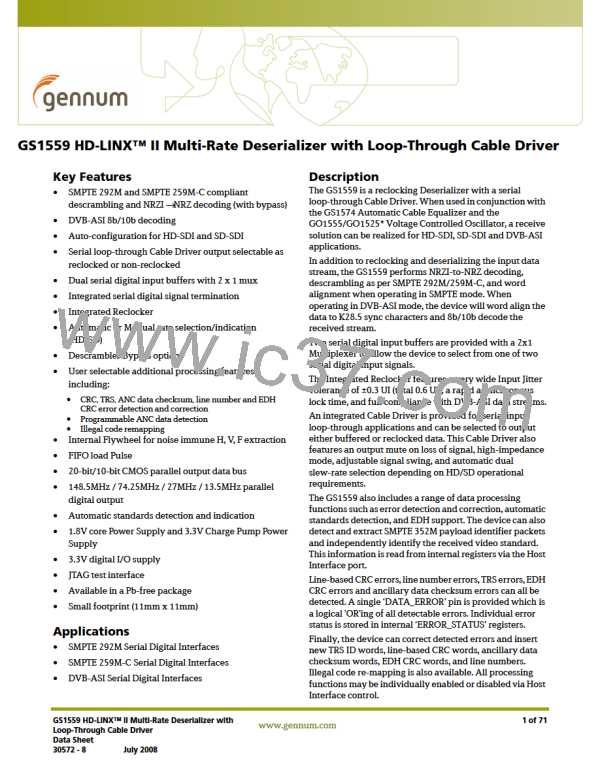4.8 DVB-ASI Functionality
The Lock Detect block may drop out of DVB-ASI mode under the following conditions:
•
•
•
•
RESET_TRST is asserted LOW
CDx is HIGH
SMPTE_BYPASS is asserted HIGH in Slave mode
DVB_ASI is asserted LOW in Slave mode
DVB_ASI functionality is only supported in Slave mode. To operate in DVB_ASI mode,
the device must be in Slave mode and the application layer must set the SD/HD pin
HIGH, in addition to setting SMPTE_BYPASS LOW and DVB_ASI HIGH.
4.8.1 DVB-ASI 8b/10b Decoding and Word Alignment
After serial-to-parallel conversion, the internal 10-bit data bus is fed to the DVB-ASI
8b/10b Decode and Word Alignment block. The function of this block is to word align
the data to the K28.5 sync characters, and 8b/10b decode and bit-swap the data to
achieve bit alignment with the data outputs.
The extracted 8-bit data will be presented to DOUT[17:10], bypassing all internal SMPTE
mode data processing.
NOTE: When operating in DVB-ASI mode, DOUT[9:0] are forced LOW.
4.8.2 Status Signal Outputs
In DVB-ASI mode, the DOUT19 and DOUT18 pins will be configured as DVB-ASI status
signals SYNCOUT and WORDERR respectively.
SYNCOUT will be HIGH whenever a K28.5 sync character is present on the output. This
output may be used to drive the Write Enable signal of an external FIFO, thus providing
a means of removing the K28.5 sync characters from the data stream. Parallel DVB-ASI
data may then be clocked out of the FIFO at some rate less than 27MHz. See Figure 4-4.
WORDERR will be high whenever the device has detected a running disparity error or
illegal code word.
AOUT ~ HOUT
TS
8
8
FIFO
FE
DDI
DDI
FF
GS1559
WORDERR
WORDERR
PCLK = 27MHz
SYNCOUT
CLK_IN
READ_CLK
<27MHz
CLK_OUT
WE
Figure 4-4: DVB-ASI FIFO Implementation Using The GS1559
GS1559 HD-LINX™ II Multi-Rate Deserializer with
Loop-Through Cable Driver
Data Sheet
38 of 71
30572 - 8
July 2008

 GENNUM [ GENNUM CORPORATION ]
GENNUM [ GENNUM CORPORATION ]